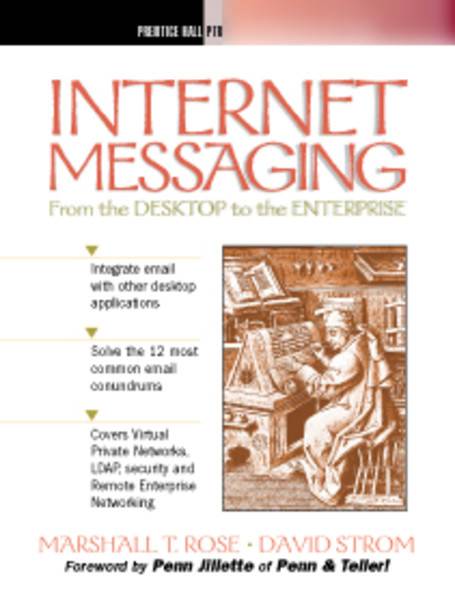Yes, it is hard to believe, but email turned 40 last month. No one can question that email has transformed the way business is conducted. According to Radicati group, the average worker processes more than a hundred daily emails, and business email accounts make up only about a quarter of the total of more than 3 billion. Sometime in the next few years, Radicati predicts that the number of IM accounts will exceed email for the first time.

Email and my own working life have been closely intertwined as well. I started using email in 1983 and over the years I have used more than three dozen different systems and sent thousands of messages. So I thought I would put together some important milestones of my own usage and show you how email has changed from those early days. In my working life, I published my first book on corporate email use (seen at left), published a weekly email newsletter and wrote many articles about various email products for dozens of publications, including this one.
And, yes, I still try to have less than ten messages at the end of each day in my inbox.
1983: Started using both MCIMail, one of the first global systems that was available to the public (the Internet was not yet available to the average worker) and a conferencing system called EIES. One job I had back then was to write automated scripts for processing messages between the two at a small software firm.
1984: At an insurance company, I used an IBM mainframe email product called DISOSS for internal communications.
1986: Used 3Com’s 3+Mail for internal communications at PC Week. This was one of the early LAN-based email programs. We thought we were hot stuff because we could hook up our remote offices around the country to it, something now taken for granted.
1987: Wrote my first column for PC Week about hotels, modems, and email. Today the problem still remains, just replace Wifi for the modems.
1989: Covered the launch of Lotus Notes, one of the first collaborative software tools, and lobbied Ziff Davis, where I worked, to start using it in place of 3+. They eventually did a few years’ later.
1990: First Internet email addresses used by writers in their bylines. We used Network Courier LAN-based email, which was the precursor to Microsoft Exchange and Outlook.
1991: Began to chart ways to send emails between two formerly disparate systems, using various gateways. The rise of Soft-Switch, which at its height could connect more than 50 different systems. They were eventually acquired by Lotus. Again, something taken for granted now.

1992: I was one of the first wireless email users of a product called RadioMail, which eventually became the BlackBerry. It worked with a one-pound radio and a one pound HP palmtop, shown at right.
1993: Obtained my first Internet domain name, strom.com, for free from Network Solutions by requesting it from them via email. Before then, private businesses couldn’t really become masters of their own domains easily.
1994: Groupware was the big deal back then, and Novell’s Groupwise was one of the best. Too bad.
1995: Began the first of a series of weekly email newsletters using a collection of Unix scripts. Still writing them, using a Linux server and Mailman.

1996: Experimented with Intermind’s push technology for notifications instead of sending emails for my newsletter. Didn’t last very long. Push pooped out quickly.
1997: Gave up my laptop and used borrowed computers when traveling. That didn’t last very long either. Did have the very early smartphone from AT&T that used broadband (well, it wasn’t all that broad) cellular data called CDPD, the precursor to what we all use today on our phones.

1998: Co-wrote my email book with Marshall Rose, the inventor of the POP protocols. The book covered the more popular email programs at the time, which included Lotus cc:Mail (extinct), Netscape Messenger (extinct but replaced by Thunderbird you could say), Eudora Pro (still very much alive, although no longer under the thumb of a phone handset maker thankfully), Compuserve (not extinct but should be), AOL (ditto and back then it was on v3), and Microsoft’s Outlook Express (v4 that came with IE v4, and replaced with the Mail app in Vista and now Windows 7). Penn Jilette, of Penn and Teller fame and an early email user, wrote our forward to our book. Out of that research is this Web page that I haven’t touched since then that shows the state of email encryption interoperability. Luckily, it has gotten better.
2001: Was a regular user of Lotus Notes, which by then had been purchased by IBM, while working back at CMP.
2002: Wrote about Michael Dell’s bandwidth separation anxiety here, probably one of the first of many popular instances of cutting off email.
2004: At the annual VIP economic forum love fest gathering in Davos, Bill Gates proclaimed: “Two years from now, spam will be solved.” Right. Not even close on that one Bill.
2005: Began using Mozilla’s ThunderBird as my regular email client. Here is a story about the trials then.
2006: Switched hosting my various email domains over to Google Apps. For free. Began using Gmail as my regular email client, it wouldn’t talk IMAP for another year.
2008: Reminisced about ten years after my email book in my post here. Vint Cerf wrote this then too about ten years of using the Internet.
2009: First of many “email is dead” articles in WSJ and elsewhere analyzed here.
2011: The latest in a series of days without email proposed to make some obscure point. We are still using it though, warts and all.
Please share you favorite email stories in our comments, especially ones from the early days.

















